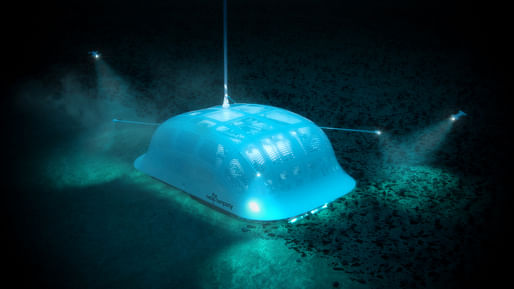
Bjarke Ingels Group (BIG) has unveiled their design for the future of metal production, combining land and sea-based elements. Collaborating with The Metals Company, a developer of lower-impact battery metals from seafloor rocks, BIG sought to bring innovative, sustainable, whole-system design processes to critical battery metals. The resulting suite of BIG’s designs includes seafloor mineral collector robots, carbon-neutral vessels, and waste-free metals processing and recycling plants to enable a circular supply chain.

The Metals Company’s production process centers on polymetallic nodules — fist-sized rocks containing battery-grade nickel, cobalt, copper, and manganese found on the ocean floor. BIG’s brief called for an integrated suite of assets that work together to lift nodules off the seafloor and up to a purpose-built production vessel, before transferring them to a hydrodynamic shuttle carrier, and onward to a land-based plant. The final plant is designed to transform an urban port site into a battery materials innovation and community hub, set within a regenerative coastal landscape.

“To collect the nodules, we have designed a light-touch, robotic collector vehicle that aims a jet of seawater across the tops of the rocks to gently pry them from the sediment,” explains Daniel Sundlin, partner at BIG and partner in charge of the collaboration with The Metals Company. “Part of our design for future collectors includes a buoyant, hydrodynamic shell with an extended lip to minimize seafloor compaction and reduce and redirect the dust plume kicked up during nodule collection.”

Nodules are transported through a flexible hose at the top of the seafloor collector vehicle to a rigid riser pipe. There, they are lifted on compressed air bubbles to the surface production vessel: a 216-meter-long ship that runs on carbon-neutral electrofuels, with a sunken deck covered in photovoltaic solar panels. The streamlined design of the production vessel is driven by functionality, with equipment for nodule collection strategically packed in the hull to minimize the size of the vessel and maximize operational efficiency.

While The Metals Company’s first production vessel is a deep-water drillship repurposed to enable pilot nodule collection, BIG’s next generation vessel design can scale to a point where 10 production vessels can enable the supply of 40 million tons of battery metals by 2050: enough to produce 280 million electric vehicles, or a quarter of the global passenger car fleet.

Once at port, the nodules are offloaded onto a conveyor and into a portside processing plant – designed by BIG as a sustainable, performative, and social campus. The circular, zero-solid-waste plant will house the refinement stages, stockpiles, and product storage alongside offices, visitor-centric experiences, and an innovation center to tie products into the EV supply chain. The Metals Company envisions multiple facilities spread across three continents, with several brownfield sites currently under consideration. These plants would eventually be retooled to recycle battery cathodes at end-of-life, closing the loop on the battery metals supply chain.
“The world is characterized by a mindset that divides the world into front of house and back of house,” says Bjarke Ingels. “The front of house is carefully designed in the form of beautiful facades and lush parks, leaving the back of house as purely utilitarian and logistical leftovers in the form of parking lots and warehouses. With The Metals Company, we are designing a human made ecosystem channeling the flow of resources with the care and attention conventionally reserved for the front of house. A next-generation materials industry."
1 Comment
I like this. I like the idea of addressing an entire process in our work, not just a pretty enclosure for a process we know nothing about.
Block this user
Are you sure you want to block this user and hide all related comments throughout the site?
Archinect
This is your first comment on Archinect. Your comment will be visible once approved.